
The 1933-34 season saw a number of changes at Warner Brothers’ cartoon division. Hugh Harman and Rudy Ising had left – and taken their main character with them. They weren’t going to let the same thing happen to them that had happened to Disney with Oswald. The animators that remained had to come up with a new character for the “Looney Tunes” series.
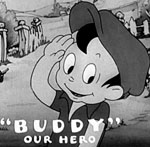 They came up with a character called Buddy, who has been referred to by many critics as “Bosko in whiteface”. Both WB series of cartoons got new themes for their opening titles. The “Merrie Melodies” switched from Harold Arlen’s “Get Happy” to a piece called, “I Think You’re Ducky”, which was not recorded by anybody, and seemingly no one has found the sheet music.
They came up with a character called Buddy, who has been referred to by many critics as “Bosko in whiteface”. Both WB series of cartoons got new themes for their opening titles. The “Merrie Melodies” switched from Harold Arlen’s “Get Happy” to a piece called, “I Think You’re Ducky”, which was not recorded by anybody, and seemingly no one has found the sheet music.
The “Looney Tunes” switched over from “Whistle and Blow Your Blues Away” to a new composition by Norman Spencer, whose name is presently unknown. Early on, this new Looney Tunes theme was played at a moderately fast tempo – after a few cartoons it was speeded up to the “Presto” tempo that continued for a few years thereafter.
Buddy’s Day Out (9/2/33) – This was the first cartoon to use the new Looney Tunes theme. Also featured was “I’ll Pin Another Petal On The Daisy” by Irving Kahal and Sammy Fain. Other songs used in this cartoon were “Young and Healthy” and Tony Jackson’s old favorite, “Pretty Baby”.
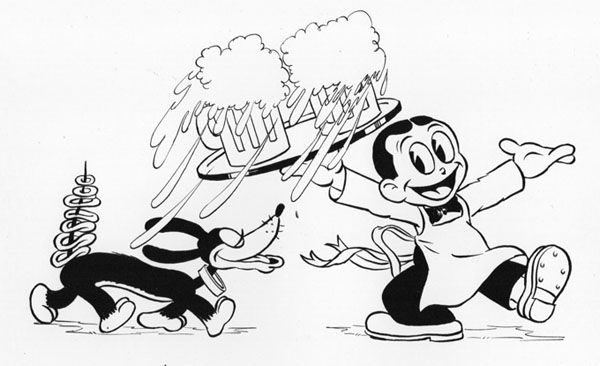
Buddy’s Beer Garden (11/11/33) – The 73rd Congress wasted no time once it was convened in passing a law legalizing beer of no more than 3.2% alcohol. Once the previously forbidden tipple was legalized, beer gardens opened up in major cities, striving for a German atmosphere as well as trying to sell brew. This may also be the first Warner cartoon to feature a gag staple – tongue sandwiches singing “La La La” to a song – which would later find a place in Goofy Groceries, among others. Songs include an appropriate “Ach Du Lieber Augustin”, suitable for all thing Teutonic. Also included: “It’s Time To Sing Sweet Adeline Again”. This song was inspired by the fact that by 1933, a 1906 song, “(You’re the Flower of My Heart) Sweet Adeline” had become associated with quartets of inebriates. This cartoon also features an original number: “My Good Time, Slow Time, Baseball Man”, a reasonable pastiche of the kind of song Mae West would perform in her pictures, and delivered by Buddy in drag as Mae West.
Buddy’s Show Boat (12/9/33) – The title vessel cruises down the river and stops to give a performance, with the usual hijinks between the heroine and the villain, with the villain getting his comeuppance via a spanking by the ship’s paddlewheel. Songs include two fairly recent tunes, “Under My Umbrella”, which seems to have been more popular on the other side of the pond than it was in this country (George Scott-Wood for Regal Zonophone, for example), along with “And So I Married the Girl” (performed by Waring’s Pennsylvanians for Victor). Also featured were several old favorites, including “Bam Bam Bammy Shore” (a 1925 hit recorded by Ted Lewis on Columbia, and an excellent vocal version by the Revelers on Victor), “There Is a Happy Land (Far Far Away)” (recorded in 1929 by Nat Shilkret and the Victor Orchestra), and “Sweet Georgia Brown” (a 1925 hit, most recently recorded by Bing Crosby with Isham Jones’ Orchestra on Brunswick). These three songs were treated as “evergreens” by the film.
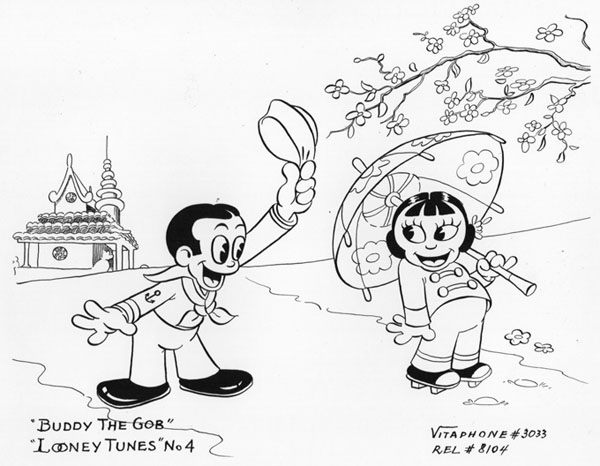
Buddy the Gob (1/13/34) – Military marches open a montage sequence of navy battleships, including “Columbia the Gen of the Ocean”, but the lion’s share of the score goes to “Shanghai Lil” from Busby Berkeley’s “Footlight Parade”, recorded widely by Gene Kardos (Melotone, etc.), and both a vocal version by Dick Powell and a dance version by Guy Lombardo on Brunswick. Plot is lifted almost verbatim from the previous year’s “One Step Ahead of My Shadow:, with Buddy rescuing sweet young thing from sacrifice to a sacred dragon.
Buddy and Towser (2/24/34) – The name “Towser” is derived from a Spanish Mission, “San Fernandez De Taos”, which produced a particularly potent potable, “Old Towse”. At times, that name was applied to a dog (a more feisty creature might be named “Fido”). There are no songs of note featured in the cartoon, nor much plot.
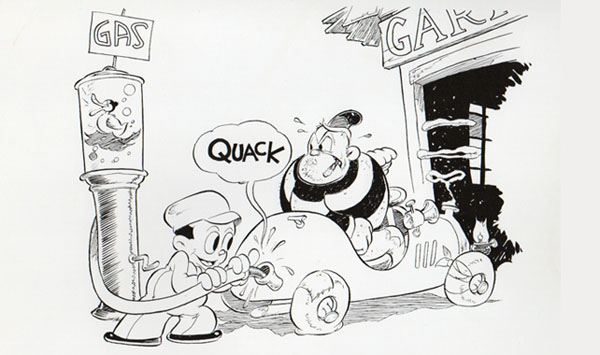
Buddy’s Garage (4/5/34) – Songs include the oldie, “California, Here I Come”, most recently recorded by Claude Hopkins and his Harlem Orchestra, as well as a more recent number, “By a Waterfall” from “Footlight Parade”, recorded by Leo Reisman on Victor, Gene Kardos (Melotone, et al.), and vocal versions by Dick Powell on Brunswick and Chick Bullock on the dime store ARC labels (with Benny Goodman in the accompanying band). This would become a common cue for Carl Stalling in later Warner Brothers cartoons, as early as “September in The Rain” and “Goofy Groceries”, and also used in the post-Stalling period in Bugs Bunny’s “Wet Hare”. Also used was “Puddin’ Head Jones”, recorded by Ben Selvin (under the pseudonym “Fren Frey” on a royal blue Columbia record, Mike Doty on the new Bluebird label (actually fronting a Joe Haymes orchestra, for whom Doty was a saxiophonist), while Melotone and associated labels had a version credited to Earl Harlan and his Orchestra (actually Don Redman’s Orchestra with vocal by Chick Bullock).
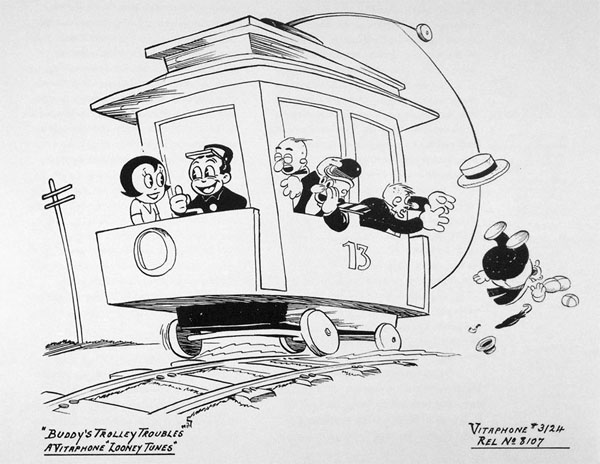
Buddy’s Trolley Troubles (5/5/34) – Two notable songs: “Why Do I Dream Those Dreams” (later used in a Merrie Melodies film of the same name), from the Warner feature Harold Teen (a comic strip which was sort of an antediluvian “Archie”, one of the first to suggest that teenagers were not simply young adults). Dick Powell got the song on Brunswick, Will Osborne on Melotone and associated labels. Another song included was “Two Little Flies On a Lump Of Sugar”, recorded by Little Jack Little for royal blue Columbia, and also memorable from a British recording by Jack Jackson and his Orchestra on HMV with vocal by visiting American Alberta Hunter. The cartoon itself at least does not seem to repeat gags going back to Oswald Rabbit’s Trolley Troubles, or any from Smile Darn Ya, Smile.
Buddy of the Apes (5/26/34) – Songs include “My Old Man”, a song associated with the “Spirits of Rhythm” recorded on Brunswick, and also recorded on Melotone and associated labels under the name Earl Harlan (again really Don Redman with vocal by Chick Bullock). Carl Stalling would remember the cue for The Coo Coo Nut Grove, giving the same song to the animated Dionne Quintuplets. A couple of oldies, one of which had been almost virtually forgotten, also show up: “Bo-La-Bo”, which had been recorded several times in 1920 by Paul Biese for Victor and by a very young Ted Lewis for Columbia. There had also been a recording in Montreal for Canadian HMV on which Billy Murray sings part of a vocal chorus. This version was issued as “Billy Murray’s Melody Men”.
The second song used here was “Peek-a-Boo, I See You”. It’s motif was used in several cartoons whenever anyone plays hide and seek – even used in competing Disney Silly Symphony, “Lullaby Land”. Buddy of the Apes itself is as politically incorrect as you can get nowadays, with plenty of native stereotypes.
Buddy’s Bearcats (6/23/34) – Baseball season for Buddy, with a lot of spectators getting in free, and play-by-play by caricature of Joe E. Browm. The one song featured is “Out For No Good”, which Ginger Rogers, Dick Powell and the Mills Brothers introduced in Twenty Million Sweethearts. At least one recording of it was cut for Bluebird by Herman Waldman in San Antonio, Texas. In England, it was recorded by Lew Stone for Decca and Harry Roy for Parlophone.
NEXT: Back to the Merrie Melodies, post Harman-Ising.


 James Parten has overcome a congenital visual disability to be acknowledged as an expert on the early history of recorded sound. He has a Broadcasting Certificate (Radio Option) from Los Angeles Valley College, class of 1999. He has also been a fan of animated cartoons since childhood.
James Parten has overcome a congenital visual disability to be acknowledged as an expert on the early history of recorded sound. He has a Broadcasting Certificate (Radio Option) from Los Angeles Valley College, class of 1999. He has also been a fan of animated cartoons since childhood.












































Oh, this was so sweet to wake up to!
With mention of these popular tunes, you’ve realized one of the reasons why I like BUDDY cartoons…and, no, I don’t entirely agree with the assessment that Buddy was a blander version of BOSKO. I dimly remember Buddy being drawn like almost every little boy in comic books, complete with cowlick, although, like Porky Pig to follow, we never quite knew if Buddy was supposed to be a little boy. Would a little boy run a “beer garden” or local pub, or dress as Mae West with a suggestive song like the one mentioned here? Perhaps, but just to unnerve his elders!
I like the version of “Bo-La-Bo” within the cartoon, but it was terrific to hear it as a popular instrumental within this post. I couldn’t be happier that we have at least three of these cartoons, fully restored, as found on the final (sigh) volume of the LOONEY TUNES GOLDEN COLLECTION series on DVD. Perhaps, with the advent of 4K and blu-ray, we’ll see the rest. I like all the cartoons above, but “BUDDY’S BEAR CATS” sticks in my head as an ear worm each time I play it. I’d love to see it as restoration real soon. “BUDDY OF THE APES” is an obvious take on the popular “TARZAN” movies produced at MGM, but the gags involving the tribesmen would never allow this title to be shown anywhere. I’m sure it was aired on TV years ago when I first started watching “LOONEY TUNES CIRCUS”, hosted by Claude Kirshner…and the “TARZAN” films were probably shown on the same channel.
As probably often noted elsewhere, there was a two-color Technicolor cartoon called “MR. AND MRS. IS THEIR NAME” which featured underwater versions of Buddy and Cookie as merman and mermaid, respectively, but I will always remember the BUDDY tritles fondly. Jack King directed a lot of these, and he would go on to do some fine work at Walt Disney Studios in the 1940’s.
Shame that Warner Brothers wouldn’t allow you to add the cartoons so everyone could re-examine them…maybe someday!
Schlesinger missed an opportunity by not using the old hit “My Buddy” as the theme music for the Buddy cartoons, but there may have been copyright issues that prevented him from doing so. “My Buddy” is a very poignant song, but a jazzed-up version of it would have suited the cartoons while remaining recognisable. It was so popular that “Buddy” became the nickname for a whole cohort of boys of that generation, for example the songwriter Buddy Kaye (1918-2002); and my dad’s first cousin Albert Shea (1918-1968), who sang in the barbershop quartet the Buffalo Bills (famous for their recordings on the Decca label as well as their appearances in the Broadway and Hollywood productions of “The Music Man”), was always known as “Buddy” to the family.
By this reckoning Buddy would have been an early adolescent in 1933, which makes sense: still young enough to be cute, but old enough to have a girlfriend and get up to real mischief.
I think the Buddy cartoons might have a better reputation today if they were more easily accessible. “My Buddy! My Buddy! Your buddy misses you!”
We all like to make fun of how bad the Buddy cartoons are, and they really aren’t good, BUT, having watched the 30’s cartoons in rough chronological order last year, I think the Buddys are a little bit better than most of the Merrie Melodies shorts that were being put out at that time.
The MMs had become *very* formulaic in terms of story, while with Buddy there was at least ATTEMPTS to do different things and different situations. They’re just not entertaining at face value.
I’ll say one thing for Buddy…he way way more interesting than *ugh* Beans.
Carl Stalling would later use “Puddin’ Head Jones” as the leitmotif for Sleepy La Goon in “YANKEE DOODLE DAFFY”.